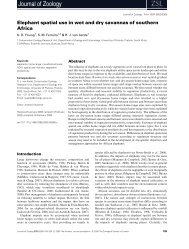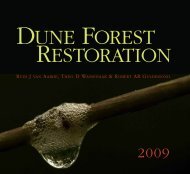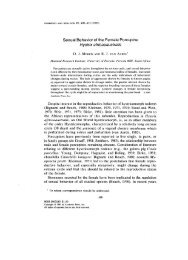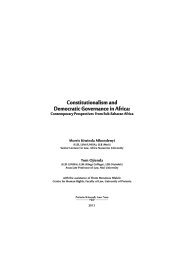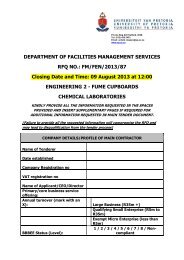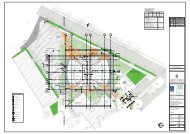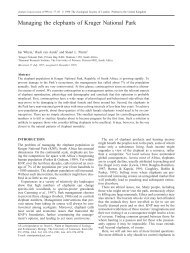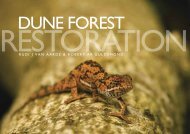Evaluation and Rating Facts & Figures - 2007 - National Research ...
Evaluation and Rating Facts & Figures - 2007 - National Research ...
Evaluation and Rating Facts & Figures - 2007 - National Research ...
You also want an ePaper? Increase the reach of your titles
YUMPU automatically turns print PDFs into web optimized ePapers that Google loves.
| 4 |<br />
EVALUATION AND RATING TRENDS AND NUMBERS<br />
THE NRF USES THE evaluation <strong>and</strong> rating system as a<br />
mechanism to nurture scholarship <strong>and</strong> grow the country’s research<br />
capacity. The collection of data over time makes it possible to follow<br />
trends in the number of rated researchers in different fields <strong>and</strong> at<br />
different institutions. Trends in the number of rated researchers<br />
in a specific field or at a specific institution highlight fields or<br />
environments where the South African research competency is<br />
strengthening or weakening. As such, it provides a basis for policy<br />
decisions on areas that need more funding <strong>and</strong> development.<br />
The evaluation <strong>and</strong> rating system reinforces the importance of<br />
internationally competitive research <strong>and</strong> stimulates healthy competition<br />
between researchers <strong>and</strong> research institutions. It dem<strong>and</strong>s that<br />
researchers are accountable <strong>and</strong> efficient. The system recognises<br />
researchers who produce quality research outputs <strong>and</strong> remain internationally<br />
competitive. Several higher education institutions use the<br />
results of the NRF evaluation <strong>and</strong> rating process to position themselves<br />
as research-intensive institutions <strong>and</strong> to recruit more research<br />
leaders. Others use it as a tool <strong>and</strong> an incentive to develop research<br />
staff. The process of evaluation <strong>and</strong> rating is outlined on page 16,<br />
with the definitions of the rating categories on pages 18 <strong>and</strong> 19.<br />
The tables <strong>and</strong> figures on the following pages provide an overview<br />
of key trends <strong>and</strong> statistics from information captured by the NRF’s<br />
<strong>Evaluation</strong> Centre.<br />
<strong>Evaluation</strong> <strong>and</strong> rating of researchers in the natural sciences<br />
<strong>and</strong> engineering (NSE) date back to 1984, while researchers<br />
in the social sciences <strong>and</strong> humanities (SSH) started participating<br />
in the process in 2002.<br />
Between 2003 <strong>and</strong> 2005, the percentage of researchers (higher<br />
education staff in academic <strong>and</strong> related positions) at South African<br />
higher education institutions with a valid NRF rating increased from<br />
8,7% to 9,8% (see Table 1).<br />
During 2005, the total number of researchers with a valid NRF rating<br />
increased to 1 652, an increase of 14% since 2003. Close to 91%<br />
of these worked for South African higher education institutions,<br />
while the rest were attached to museums, science councils, national<br />
research facilities or left South Africa to work abroad (see Figure1).<br />
“Measuring oneself against the best in the<br />
world is the only benchmark for a science<br />
system that aspires to become globally<br />
competitive. The current review of the<br />
NRF rating system should spell out best<br />
practice to support an upward trajectory<br />
in the competitive performance of our<br />
national science system as a whole.”<br />
Dr Albert S van Jaarsveld,<br />
Vice-President: <strong>Research</strong> <strong>and</strong> Innovation Support <strong>and</strong> Advancement (RISA), NRF<br />
Figure 1: Distribution of researchers with a valid NRF rating<br />
in 2003 compared to 2005<br />
South African higher education institutions<br />
1 306<br />
1 501<br />
South African museums<br />
18<br />
21<br />
Other South African institutions <strong>and</strong> national facilities<br />
34<br />
61<br />
Other (including institutions abroad)<br />
89<br />
69<br />
NUMBER OF RATED RESEARCHERS<br />
2003 TOTAL 1 447<br />
2005 TOTAL 1 652<br />
Table 1: Percentage of researchers with a valid NRF rating in higher education in South Africa<br />
2003 2005<br />
Total number of higher education staff in academic <strong>and</strong> related positions in South Africa* 14 976 15 315<br />
Number of rated researchers in higher education in South Africa 1 306 1 501<br />
% Rated 8,7% 9,8%<br />
*Higher Education Management Information System (HEMIS) Report, Department of Education (DoE), 2003 <strong>and</strong> 2005






